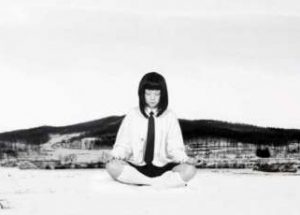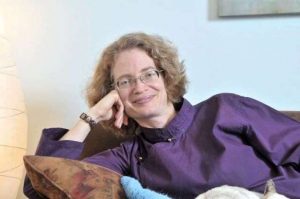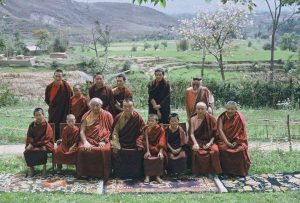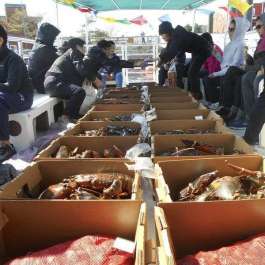
Few of us undergo a truly religious experience. Many who do, pass a new milestone in their lives and emerge with a transformed vision of how they should live and act in the world. I can confidently write that one of Mrs. Lee Mei-yin’s turning points in life was one such experience. I had joined her most recent Dunhuang tour entourage (June 16 – 23, 2014) at her invitation, and our group spent entire days exploring the Buddhist caves. Most of us were exhausted. As usual, Mrs. Lee rarely appeared tired despite talking and walking all day (a common compliment among those who travel with her frequently). One night, she managed to catch up with me for an interview in the Silk Road Dunhuang Hotel’s comfortable lobby.
To attribute religious experiences to people is a strong assertion. Yet she credits everything she has accomplished, including her 2010 – 2015 tenure as Dunhuang Academy Special Researcher (she was granted this fellowship for her project on mapping Dunhuang in 3D), to a single event in 1999. “It was the same year I started researching Dunhuang. I had been wandering around this exhibit at the National Museum of China. Then I encountered a Northern Wei statue of a Buddha, from Qingzhou in Shandong,” she gushes. “This Buddha image was heavily damaged, but make no mistake: I wasn’t just some visitor looking upon an exhibit. At that moment, I felt like I was meeting a presence unlike any other.”
A mysterious force, as she calls it, compelled her to return to the statue and fall in love with Northern Wei art. “That day was powerful. I made an inner wish right then and there: if only more people could understand, as I felt I had, the immense beauty and affective sway of Buddhist sculpture. At that point my wish was most intense for people in Hong Kong.” But soon she had the opportunity to elevate the appreciation of Buddhist art to new heights. “I later discovered I had karmic affinity with that Northern Wei Buddha, because it was brought to Hong Kong. When I listened to a talk about the exhibit, I felt it to be somewhat boring. I have no formal training in Silk Road studies or Buddhist art, but something inside prompted me to think about what I could do to contribute.”
Since 2010 she has been coming to Dunhuang regularly for both private research and tours with students. On the first two visits, she had no idea that she would become one of Hong Kong’s most sought-after teachers on Dunhuang, Buddhist art, and Chinese material culture (she started with writing and lecturing on marriage customs and conventions of beauty). On her third trip, she was asked to give a talk about the area, and after a delay she frantically began reading copiously on the subject. With support from her friends, family, and husband Prof. Lee Chack-fan, she was preparing night and day for her classes, meeting the legendary Dunhuang Academy Director Fan Jishi, and travelling back to and fro from Hong Kong to Dunhuang each year to build on her work. “I visited Dunhuang two times with Mr. Ho [Robert H. N. Ho, founder of the Robert H. N. Ho Family Foundation and Buddhistdoor], and we both enjoyed it,” she recalls proudly. “The trips just continued until I started to organically develop my own teaching style. It seems to get people interested.”
Central to her cultural and artistic contributions is an unapologetic pride in being Chinese and Buddhist. “We Buddhists need to ask ourselves some serious questions,” she tells me. “Why should a Buddhist not value Buddha images? Why do people of all backgrounds love having a Buddha in their home or office? And, most crucially, why are today’s Buddhist sculptures often made poorly? We need to revisit what is here in Dunhuang so we can be reminded of the glory we can achieve.”
She argues that Buddhism’s image in China has suffered for the past century thanks to a lack of cultural awareness and appreciation of Buddhist culture on part of both Buddhists and non-Buddhists. “I think there is a possible long-term solution. We need to improve ourselves if we’re to improve Buddhism’s image. We must work towards becoming more cultured and artistically refined devotees, and provide educational resources to those who need them. And we must ask all Buddhists we know to do the same.” In other words, as people of culture, Buddhists must at least provide a positive impression that non-Buddhists can respect.
Mrs. Lee’s plan incorporates three vital virtues in her lectures and tours: faith (religion), artistic taste (culture), and academic erudition (scholarship). At the heart of her teaching style is a focus on the everyday; a mere hairbrush might contain an entire family’s story. Glimpses of family, romantic, intimate life have enchanted her audiences far more than the traditional narratives of empires, conquest, and edicts. “Scholarship should be done in the real world. True culture is seen in the everyday. Think of it this way: we talk about the Chinese middle class, a diverse demographic who occupy a bridge between the wealthy and the poor. But we only have an economic middle class. We have no cultural middle class who can understand elitist academics, but who can also identify with the culturally impoverished.” In China, we find ourselves swinging between a culturally unequipped majority and a minority of isolated experts who talk mostly among their cloistered circles. Mrs. Lee sees this as the defining cultural problem of our time, and her lack of formal training seems to be a boon in this sense.
“With all that said, I always say that we need to study deeply the karma we have with people, with things, with events. I think for all the Buddhist teachings I’ve absorbed over the decades, I can be honest when I say my personality hasn’t changed much,” she laughs. “I’ve always lived in the moment and gone with the flow. I’ve floated here and there, whether it was my life in Canada or my teaching about the Silk Road, Dunhuang, or art. I don’t feel attached now, and I feel free.”
She is emphatic about having lived without plans, even to this day. “I really didn’t plan my entry into studying material culture, and I certainly never had any long-term objective in teaching. Really!” she laughs, noticing my grin. “I’m not obsessed with plans about life, about work, about relationships. I live by the conditions dealt to me (yuan fen 緣分) and gratitude (gan en xin 感恩心). That’s all that was needed to take me here to beautiful Dunhuang.”
Perhaps Mrs. Lee’s insistence on the primacy of karma and conditions over her own agency is natural. We know that the sun gives light far and wide, but do we ever ask it what it wants to shine on?

















